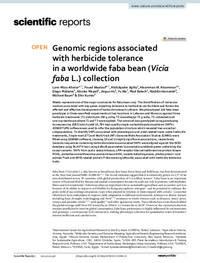Genomic regions associated with herbicide tolerance in a worldwide faba bean (Vicia faba L.) collection

Authors:
Weeds represent one of the major constraints for faba bean crop. The identification of molecular markers associated with key genes imparting tolerance to herbicides can facilitate and fasten the efficient and effective development of herbicide tolerant cultivars. We phenotyped 140 faba bean genotypes in three open field experiments at two locations in Lebanon and Morocco against three herbicide treatments (T1 metribuzin 250 g ai/ha; T2 imazethapyr 75 g ai/ha; T3 untreated) and one in greenhouse where T1 and T3 were applied. The same set was genotyped using genotyping by sequencing (GBS) which yield 10,794 high quality single nucleotide polymorphisms (SNPs). ADMIXTURE software was used to infer the population structure which revealed two ancestral subpopulations. To identify SNPs associated with phenological and yield related traits under herbicide treatments, Single-trait (ST) and Multi-trait (MT) Genome Wide Association Studies (GWAS) were fitted using GEMMA software, showing 10 and 14 highly significant associations, respectively. Genomic sequences containing herbicide tolerance associated SNPs were aligned against the NCBI database using BLASTX tool using default parameters to annotate candidate genes underlying the causal variants. SNPs from acidic endochitinase, LRR receptor-like serine/threonine-protein kinase RCH1, probable serine/threonine-protein kinase NAK, malate dehydrogenase, photosystem I core protein PsaA and MYB-related protein P-like were significantly associated with herbicide tolerance traits.
